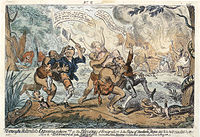Roman austral: Difference between revisions
(Created page with "200px|thumb|A racist depiction of a [[Xiaodong|Xiaodongese man. Such illustrations were a key part of the genre.]] The '''''Roman austral''''', in {{...") |
No edit summary |
||
| Line 1: | Line 1: | ||
[[File: | [[File:Cruikshank All among the Hottentots capering to shore 1820.jpg|200px|thumb|A racist depiction of a [[Bahia|Bahians]]. Such illustrations were a key part of the genre, which showed such cultures as savage.]] | ||
The '''''Roman austral''''', in {{wp|English language|Estmerish}} '''Austral Novel''', was a genre of {{wp|literature}} which arose in colonial era [[Euclea]], particularly [[Gaullica]] which is regarded as the birthplace of the genre. As a genre, the ''Roman austral'' was centred on often {{wp|exoticism|exoticised}} stories depicting [[Coius|Coian]] cultures and wildlife, with the protagonists invariably being white Euclean adventurers. Such stories focused primarily on excitement and instilling a desire for colonial adventure among the Euclean populations, sacrificing realistic portrayal of cultures and peoples in favour of ones which would inspire Euclean imaginations. | The '''''Roman austral''''', in {{wp|English language|Estmerish}} '''Austral Novel''', was a genre of {{wp|literature}} which arose in colonial era [[Euclea]], particularly [[Gaullica]] which is regarded as the birthplace of the genre. As a genre, the ''Roman austral'' was centred on often {{wp|exoticism|exoticised}} stories depicting [[Coius|Coian]] cultures and wildlife, with the protagonists invariably being white Euclean adventurers. Such stories focused primarily on excitement and instilling a desire for colonial adventure among the Euclean populations, sacrificing realistic portrayal of cultures and peoples in favour of ones which would inspire Euclean imaginations. | ||
Revision as of 05:46, 2 January 2021

The Roman austral, in Estmerish Austral Novel, was a genre of literature which arose in colonial era Euclea, particularly Gaullica which is regarded as the birthplace of the genre. As a genre, the Roman austral was centred on often exoticised stories depicting Coian cultures and wildlife, with the protagonists invariably being white Euclean adventurers. Such stories focused primarily on excitement and instilling a desire for colonial adventure among the Euclean populations, sacrificing realistic portrayal of cultures and peoples in favour of ones which would inspire Euclean imaginations.
The first Roman austral is generally considered to be Renée Daumec's 1830 work Au cour du roi des pygmées, which was set within the jungles of the Masamongo in modern day Mabifia. While Bahia was the dominant setting for such novels, given its perceived "primitiveness" compared to Euclea, such novels also explored Satria and the Great Steppe. The genre reached its high point during the late 19th century, as the Fatougole saw the rapid annexation of much of Bahia, before waning in popularity through the efforts of the Euclean Society of Austral and Oriental Anthropology and development of native Coian literature in Euclean languages which challenged the image painted by the pro-colonial Romanciers australs. In modern literary criticism, the genre is seen in a mostly negative light due to its role in the advancement of colonialism.